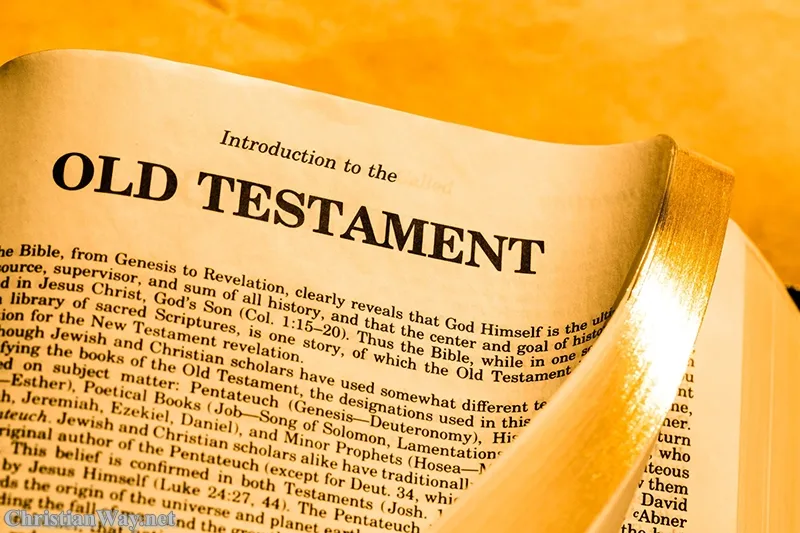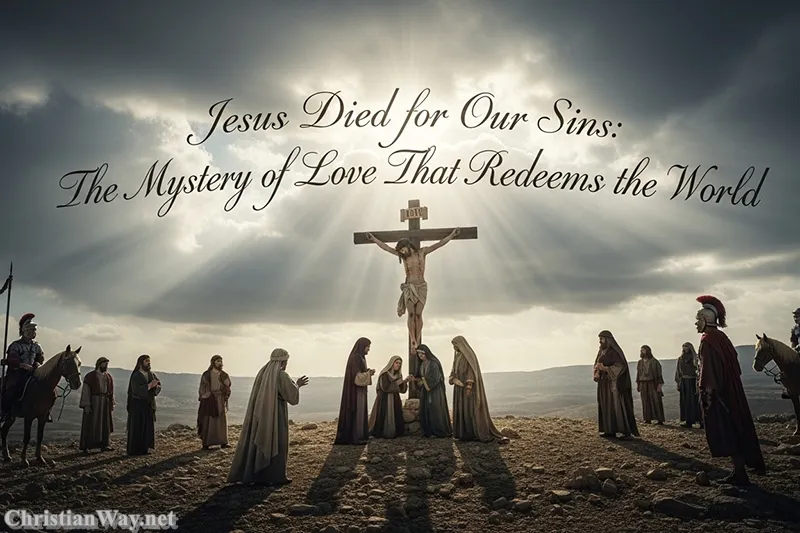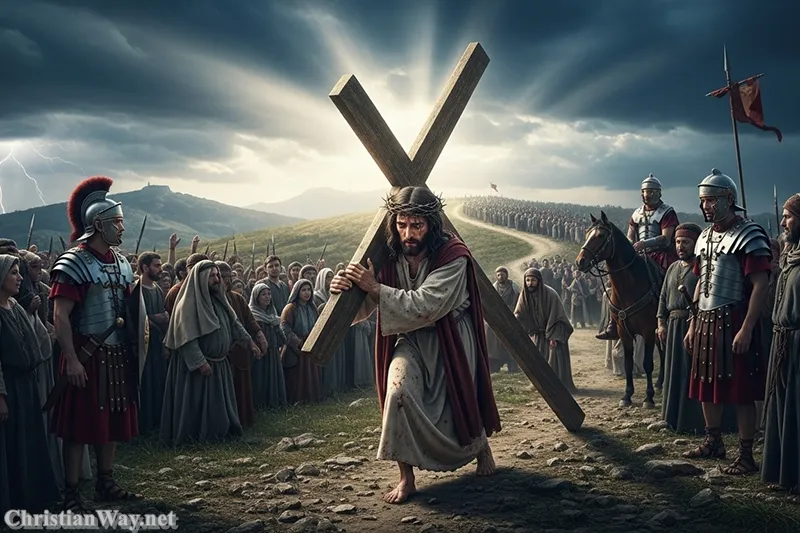Dear friends in Christ,
Every human heart, at some point, stands before the mystery of suffering and love. We ask why pain exists, why injustice seems to prevail, and whether love can truly overcome death. For the Christian, this question finds its answer not in theory, but in a Person — the crucified Jesus. Upon the Cross, heaven and earth meet; justice and mercy embrace; sin is defeated not by violence, but by love that refuses to stop giving.
The Cross of Jesus Christ is not merely an ancient event; it is the living center of all history and of every human story. It is the key to understanding who God is and who we are called to become. When we gaze upon the crucified Lord, we see not only our redemption but also the face of divine tenderness — a love so total that it enters the darkest depths of our brokenness and turns them into the path toward resurrection.

Let us walk slowly through this mystery: what the Cross means, what it reveals, and how it transforms the way we live, suffer, and hope.
The Cross: The Heart of the Christian Faith
The Cross as Revelation
At the heart of Christianity stands not a symbol of power or conquest, but of love poured out. The Apostle Paul writes, “We preach Christ crucified, a stumbling block to Jews and foolishness to Gentiles, but to those who are called, Christ the power of God and the wisdom of God” (1 Corinthians 1:23–24). The world could not comprehend that true power might appear in weakness, that divine victory might come through self-giving love.
In the Cross, God reveals His innermost nature — not as a distant ruler demanding sacrifice, but as a Father who Himself becomes the sacrifice. The wood of the Cross is the throne of the Servant King, the altar of divine mercy, and the sign that love will go to the uttermost to save.
The Cross as Fulfillment
The Cross fulfills the story of Israel — the covenant of love begun with Abraham, the sacrifices of the Temple, the Passover deliverance from slavery. Jesus becomes the true Lamb whose blood saves not only one nation, but the whole human race. As St. John declares, “Behold the Lamb of God, who takes away the sin of the world” (John 1:29).
Every prophecy finds its meaning here. Isaiah saw it long before: “He was pierced for our transgressions, crushed for our iniquities; upon him was the punishment that brought us peace” (Isaiah 53:5). The Cross is not an accident of history but the eternal plan of love — God bending down to lift humanity up.
The Cross and the Mystery of Sin
The Human Wound
To understand the Cross, we must first understand sin — not merely as a list of wrongs, but as the deep rupture between the human heart and its Creator. Sin isolates us; it breaks communion; it enslaves us to self-centeredness. We see its effects in every division, every injustice, every fear that drives us away from love.
Christ takes upon Himself not only the punishment for sin but the very weight and consequence of it. He stands where we should have stood — not as one condemned by God’s anger, but as one who enters our estrangement to restore communion. The Cross is the moment when the sinless One becomes sin for us, so that in Him we might become the righteousness of God (2 Corinthians 5:21).
The Divine Exchange
In His Passion, Jesus does not simply suffer instead of us; He suffers with us and for us. This is the divine exchange — our sin for His holiness, our wounds for His healing, our death for His life. Through His obedience even unto death, the Son restores what human disobedience destroyed.
The Cross is therefore not God’s wrath unleashed, but God’s mercy revealed. The Father does not punish the Son; rather, the Son offers Himself freely in perfect love, reconciling the world to the Father. The Triune God acts in unity — Father, Son, and Holy Spirit — to redeem creation through self-giving love.
The Cross and the Love of God
Love to the End
The Gospel of John describes the Passion with these profound words: “Having loved His own who were in the world, He loved them to the end” (John 13:1). The Cross is the visible proof that there is no limit to God’s love. Every nail, every wound, every breath He gave was a declaration: “You are worth everything to Me.”
When we look upon the Cross, we see the true measure of divine love — not in feelings, but in faithfulness. Jesus does not love us because we are good; He loves us in order to make us good. He does not wait for our repentance; He loves us into repentance. The Cross is not the condition for God’s love — it is its most luminous expression.
Love That Redeems
Love, in its truest form, is always redemptive. It bears the pain of another, transforms suffering into compassion, and turns even death into a passage toward life. The Cross shows that divine love is not a soft sentiment, but a fierce, purifying fire.
St. Catherine of Siena once said, “The Cross is a tree that bears fruit only when watered with tears.” It is there, in our sorrow, that we meet the redeeming tenderness of God. For every human pain finds its echo in the wounds of Christ. And from those wounds flows healing grace — the water and blood that signify the birth of the Church and the renewal of the soul.
The Cross and the Power of Resurrection
From Death to Life
The Cross cannot be separated from the Resurrection. The two are one mystery — the Paschal Mystery — through which death is conquered and new life begins. On Good Friday, love descends to the deepest darkness; on Easter morning, love rises triumphant.
By His Cross, Christ breaks open the gates of death. As the ancient Easter hymn proclaims: “By dying He destroyed our death; by rising He restored our life.” The Cross, once a symbol of despair, becomes the sign of eternal hope. The tomb that held the dead becomes the cradle of immortality.
Sharing in His Victory
Through baptism, every Christian is united with this mystery: “We were buried therefore with Him by baptism into death, so that as Christ was raised from the dead, we too might walk in newness of life” (Romans 6:4).
To take up our cross daily means to share in His death and resurrection — to let go of pride, resentment, and fear, and to live from the power of love that cannot die. The Cross teaches us that every suffering endured in faith becomes a seed of resurrection.
The Cross and the Christian Life
The Way of Discipleship
Jesus said plainly, “If anyone would come after Me, let him deny himself and take up his cross daily and follow Me” (Luke 9:23). To follow Christ means not to escape the cross, but to carry it in love. This does not glorify pain for its own sake, but transforms it through purpose.
Every cross — the burdens of life, the call to forgive, the struggle to remain faithful — becomes a participation in His redemptive love. When we embrace our crosses with Christ, they cease to be curses and become altars of grace.
The Cross in Daily Living
In the family, the Cross might mean patience when love is tested. At work, it might mean integrity when compromise seems easier. In our inner life, it often means trust when God seems silent. To live beneath the Cross is to believe that love always has the final word — even when we do not yet see it.
The saints teach us that joy and the Cross are never far apart. St. Francis of Assisi called it “perfect joy” to bear hardship for the sake of love. St. Thérèse of Lisieux found in the small crosses of daily life her path to holiness. The Cross does not remove suffering; it gives it meaning.
The Cross and the Church
The Cross as Foundation
The Church is born from the pierced side of Christ — water and blood flowing out as symbols of Baptism and Eucharist (John 19:34). Every sacrament is a participation in the power of the Cross. The Church’s mission is to proclaim this mystery to the world, not by dominance, but by service and compassion.
At every Mass, the Cross is made present anew — not as repetition, but as sacramental participation. The Eucharist is the unending echo of Calvary: “This is My Body, given for you… This is My Blood, poured out for you.” When we approach the altar, we stand once more at the foot of the Cross, where heaven touches earth.
The Cross as Unity
The Cross also unites all Christians. Though divided by history and doctrine, every branch of the Christian family — Catholic, Orthodox, Protestant, and Anglican — gathers beneath the same Cross. It is the sign of our common redemption and the hope of our ultimate reconciliation.
When believers from every tradition fix their eyes on the crucified Lord, they rediscover the source of unity that transcends all differences: the love of Christ that “compels us” (2 Corinthians 5:14).
Reflect and Pray
Dear friends, the Cross of Jesus Christ stands at the center of time and eternity. It is the point where divine mercy meets human misery, where love answers sin with forgiveness, and where death gives birth to life.
To carry the Cross is not to live in sadness, but to live in truth — to see the world as it is, and to love it as God does. The Cross teaches us that every wound can become a door to grace, and every sorrow, when offered in love, becomes part of Christ’s redeeming work.
Let us then make the sign of the Cross not as a habit, but as a confession of faith: that we belong to the Crucified and Risen Lord, and that through His Cross, the world is being made new.
“We adore You, O Christ, and we bless You,
because by Your holy Cross, You have redeemed the world.”
May the peace of the Crucified Lord dwell in your heart.
May His wounds heal your wounds, and His love be your strength.
— Fr. John Matthew, for Christian Way





